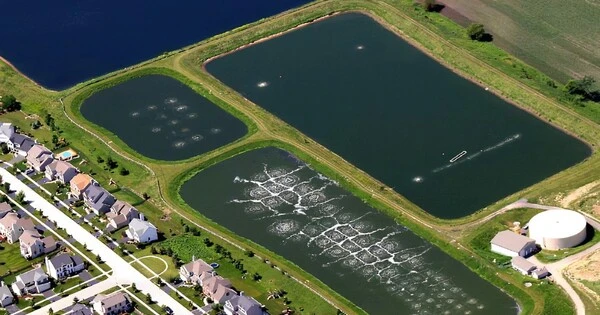Aerated lagoons are a type of wastewater treatment that uses aeration principles to break down organic contaminants in water. It is a straightforward wastewater treatment system that consists of a pond with artificial aeration to enhance biological oxidation of waste waters. This technique is widely used in municipal and industrial wastewater treatment plants.
Activated sludge, trickling filters, rotating biological contactors, and biofilters are just a few of the additional aerobic biological wastewater treatment technologies. They all use oxygen (or air) and microbial action to lower pollution levels in wastewater.
Types
Suspension mixed lagoons use less energy from the aeration equipment to keep the sludge suspended.
Facultative lagoons occur when the aeration machinery does not produce enough energy to keep the sludge suspended and solids settle to the lagoon floor. The biodegradable solids in the settling sludge then decay in the same way as they would in an anaerobic lagoon.
Here’s a basic overview of how an aerated lagoon works:
- Basics of Lagoon Systems: A lagoon is essentially a large, shallow pond or basin where wastewater is held for an extended period, allowing natural processes to treat the water. Lagoons can be anaerobic (without oxygen) or aerated (with oxygen).
- Aeration in Aerated Lagoons: In aerated lagoons, aeration is a key component. Aeration involves the introduction of air into the wastewater to stimulate the activity of aerobic microorganisms. Aerobic microorganisms require oxygen to break down and consume organic pollutants in the water.
- Aeration Equipment: Aeration is often achieved using mechanical devices such as aerators, diffusers, or mechanical surface agitators. These devices help in the transfer of oxygen from the atmosphere into the water, promoting the growth of beneficial bacteria that consume organic matter.
- Microbial Treatment: The introduced oxygen supports the growth of aerobic bacteria and other microorganisms. These microorganisms feed on and break down organic pollutants in the wastewater, converting them into simpler and less harmful substances.
Benefits
- Relatively simple and cost-effective compared to some advanced treatment methods.
- Effective in treating a variety of wastewater types.
- Low energy requirements compared to some other treatment processes.
Proper design and management are essential to ensure optimal performance. Environmental factors such as temperature can influence microbial activity, affecting treatment efficiency.















